Assam is no longer a prisoner of geography. The state is breaking all barriers and is emerging as the fastest growing state in the country. T P Venu
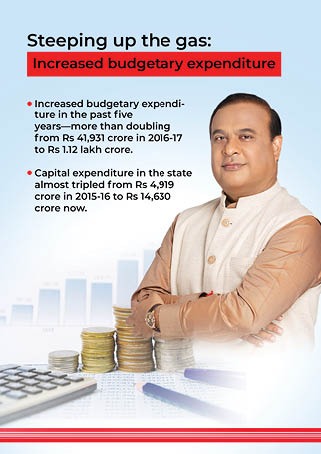 Assam is ‘The’ place to invest is what one is beginning to hear more often. All the scepticism of yesteryears of an area infested with insurgency and lack of connectivity is now replaced with the words such as ‘growth’ and ‘development.’ For a long time, when Assam was mentioned, people attributed it to backwardness. Assam has been a prisoner of geography. The apathy and ignorance about the potential the state has now been laid to rest as Assam has started punching above its weight in all indexes and is the fastest growing state in the country.
Assam is ‘The’ place to invest is what one is beginning to hear more often. All the scepticism of yesteryears of an area infested with insurgency and lack of connectivity is now replaced with the words such as ‘growth’ and ‘development.’ For a long time, when Assam was mentioned, people attributed it to backwardness. Assam has been a prisoner of geography. The apathy and ignorance about the potential the state has now been laid to rest as Assam has started punching above its weight in all indexes and is the fastest growing state in the country.
The state is blessed with natural resources but few know of its immense potential. Sample this: As per ONGC and OIL forecasts, oil production in the NER would reach 5.92 million metric tons per annum (MMTPA) and natural gas production 20.57 million metric standard cubic meters per day (MMSCMD) by FY2025. The major portion of this production is attributable to Assam. 20% of the ginger production in India is from the North Eastern Region (NER) and a sizable share is from Assam. India has 37.8% of the world’s bamboo forest area next only to the People’s Republic of China. There are 85,344 tea gardens in Assam (comprising 84,577 small tea growers and 767 big tea growers) that cover 304,000 hectares of land. About one-sixth of the tea produced in the world comes from Assam and Assam tea is currently exported to over 70 countries. Among Indian states, Assam has the highest area under pineapple cultivation.
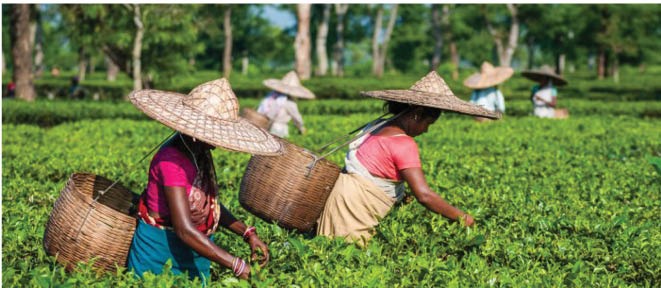
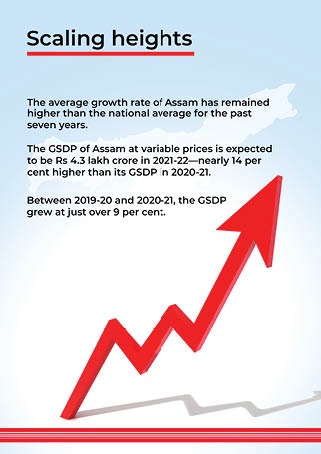 The turnaround is attributed to a sound governance model under the leadership of Chief Minister Himanta Biswa Sarma. While other states were reeling under the Covid-19 pandemic, Assam exhibited growth. (Read the interview of Dr S Lakshman, IAS, Secretary, Department of Industries, Commerce & PE, Mines & Minerals on P Nos: 26-27). The state has continuously clocked double-digit growth in the past several years and the capital expenditure in the state almost tripled from Rs 4,919 crore in 2015-16 to Rs 14,630 crore at present. The average growth rate of Assam has remained higher than the national average for the past seven years. The GSDP of Assam at variable prices is expected to be Rs 4.3 lakh crore in 2021- 22—nearly 14 per cent higher than its GSDP in 2020- 21. Between 2019-20 and 2020-21, the GSDP grew at just over 9 per cent.
The turnaround is attributed to a sound governance model under the leadership of Chief Minister Himanta Biswa Sarma. While other states were reeling under the Covid-19 pandemic, Assam exhibited growth. (Read the interview of Dr S Lakshman, IAS, Secretary, Department of Industries, Commerce & PE, Mines & Minerals on P Nos: 26-27). The state has continuously clocked double-digit growth in the past several years and the capital expenditure in the state almost tripled from Rs 4,919 crore in 2015-16 to Rs 14,630 crore at present. The average growth rate of Assam has remained higher than the national average for the past seven years. The GSDP of Assam at variable prices is expected to be Rs 4.3 lakh crore in 2021- 22—nearly 14 per cent higher than its GSDP in 2020- 21. Between 2019-20 and 2020-21, the GSDP grew at just over 9 per cent.
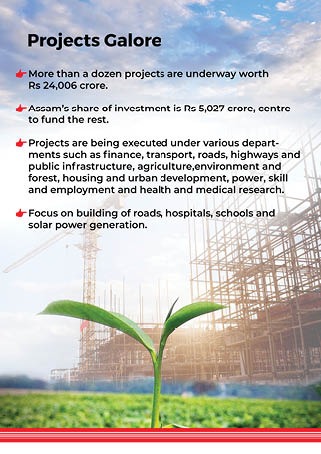 Projects underway
Projects underway
Just a few years ago, one could cover Guwahati within an hour and the city would go to sleep by 9 p.m. Today, all that has changed and one can see hectic activity, says Drubjyoti, a private employee and resident of Beltola in Guwahati. He adds, “Flyovers are being built, work on the highway is going on at brisk pace and there is a sense of peace and calm. In all, close to a dozen projects ranging from solar, roads, schools, hospitals, re-carpeting or roads, healthcare and medical research and establishment of cancer hospitals (See interview of Dr Siddharth Singh, IAS, Commissioner & Secretary, Medical Education and Research. Pg Nos 26-27) are underway all worth Rs 24,006 crore.
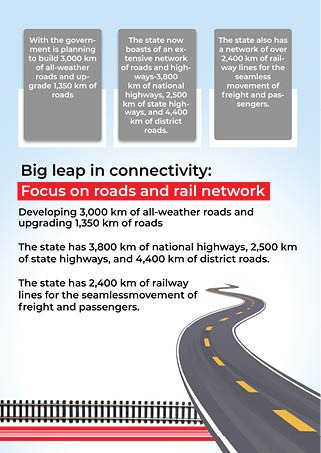 The biggest hurdle in the development of Assam and the North Eastern Region (NER) as a whole has been connectivity. It is probably for the first time since Indian Independence that such an extensive development of roads and highways has been taken up. About 1,350 km of roads up gradation, 3,000 km of roads, and 4,400 km of rural roads is being undertaken. This apart, high-speed corridors are planned. Assam has allocated 8% of its total expenditure on roads and bridges, which is higher than the average allocation by states (4.7%).
The biggest hurdle in the development of Assam and the North Eastern Region (NER) as a whole has been connectivity. It is probably for the first time since Indian Independence that such an extensive development of roads and highways has been taken up. About 1,350 km of roads up gradation, 3,000 km of roads, and 4,400 km of rural roads is being undertaken. This apart, high-speed corridors are planned. Assam has allocated 8% of its total expenditure on roads and bridges, which is higher than the average allocation by states (4.7%).
As per ONGC and OIL forecasts, oil production in the NER would reach 5.92 million metric tons per annum (MMTPA) and natural gas production 20.57 million metric standard cubic meters per day (MMSCMD) by FY2025
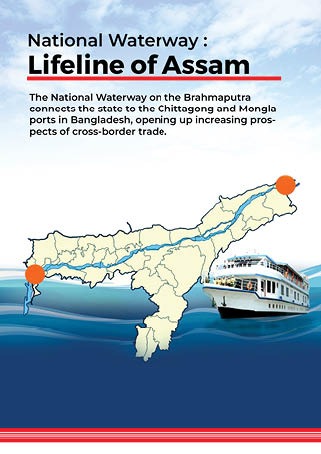 The topography of Assam is such that inland waterways and national waterway form the lifeline of the state. The National Waterway on the Brahmaputra connects the state to the Chittagong and Mongla ports in Bangladesh, opening up increasing prospects of cross-border trade. Another significant waterway is the National Waterway 16 on the Barak River in South Assam.
The topography of Assam is such that inland waterways and national waterway form the lifeline of the state. The National Waterway on the Brahmaputra connects the state to the Chittagong and Mongla ports in Bangladesh, opening up increasing prospects of cross-border trade. Another significant waterway is the National Waterway 16 on the Barak River in South Assam.
According to the Inland Water Authority of India (IWAI), approximately 3 million tonnes cargo per annum can move through waterways. The development of waterways and the operationalization of the India–Bangladesh protocol routes will significantly boost the movement of goods in and out of NER. It is likely to significantly reduce the cost of transportation as compared to overland NER– mainland India goods movement through the Siliguri Corridor.
According to the Inland Water Authority of India (IWAI), approximately 3 million tonnes cargo per annum can move through waterways
Rail network: Need of the hour
 Thanks to the undulating terrain and the mighty Brahmaputra River, rail connectivity has always been found wanting not just in Assam but connecting the other north eastern states. In what can be termed as a major breakthrough, for the first time three rail bridges are available for two different circles at Pancharatna, Saraighat and Dhemaji-Dibrugarh connecting the North and South banks of River Brahmaputra.
Thanks to the undulating terrain and the mighty Brahmaputra River, rail connectivity has always been found wanting not just in Assam but connecting the other north eastern states. In what can be termed as a major breakthrough, for the first time three rail bridges are available for two different circles at Pancharatna, Saraighat and Dhemaji-Dibrugarh connecting the North and South banks of River Brahmaputra.
The Bogibeel Bridge, a road and rail bridge over the Brahmaputra River between Dhemaji and Dibrugarh districts connects the town of Dibrugarh in the south to Dhemaji to the river’s north. There is connectivity to Agartala, Mizoram, Tripura and Manipur. Nabajit, 38, a tea agent says, “Alternative routes from Guwahati to Silchar is crucial in not just connecting to the mainland India but also to ASEAN countries.”
Airborne transport network
 Assam is landlocked and connects with Siliguri corridor to the west and is the bridge to other north eastern states and rest of India as well as between Bangladesh, Bhutan, India, Nepal (BBN) and Association of Southeast Asian Nations (ASEAN). With the states prone to floods and landslides, airborne traffic network becomes critical for domestic as well as international connectivity. Dr S Lakshman, Secretary, Department of Industries, Commerce & PE, Mines & Minerals asks, “Which state can boast of so many international capitals that are just a few hours away by flight?” The added advantage is according to industry experts is medium haul aircrafts operated by carriers in domestic circuits would be enough to connect with ASEAN countries. However, Guwahati and Silchar airports are over utilized and need expansion to reduce delays in operations.
Assam is landlocked and connects with Siliguri corridor to the west and is the bridge to other north eastern states and rest of India as well as between Bangladesh, Bhutan, India, Nepal (BBN) and Association of Southeast Asian Nations (ASEAN). With the states prone to floods and landslides, airborne traffic network becomes critical for domestic as well as international connectivity. Dr S Lakshman, Secretary, Department of Industries, Commerce & PE, Mines & Minerals asks, “Which state can boast of so many international capitals that are just a few hours away by flight?” The added advantage is according to industry experts is medium haul aircrafts operated by carriers in domestic circuits would be enough to connect with ASEAN countries. However, Guwahati and Silchar airports are over utilized and need expansion to reduce delays in operations.
According to Airports Authority of India (AAI), almost all airports have shown double-digit passenger traffic growth in 2018/19 and with the decline of Covid cases, the sector is picking up. Connectivity to Myanmar, essential for India to link with the ASEAN market, is being improved under the India–Myanmar– Thailand Trilateral Highway and Asian Highway programs.
While tea is the king and contributes immensely, horticultural products could be the game changer for Assam in the coming years. Pineapple and ginger can be what mekhla chader and Assam tea have done, meaning become synonymous with Assam. The state has the highest area under pineapple cultivation in the country and ginger is majorly produced in the districts of Barpeta, Kamrup, Darrang, and Sonitpur. As per 2016/17 data at 166,500 MT Assam was the largest producer of ginger across Indian states.
Senior officials of the agricultural department state that work is apace in developing collection centers to feed into storage and processing infrastructure, setting up of climatecontrolled storage for horticultural and spice crops, improving transport from farms or mandis and ensuring that storage includes grading, packing, and other processing facilities.
According to Airports Authority of India (AAI), almost all airports have shown double-digit passenger traffic growth in 2018/19 and with the decline of Covid cases
Oil is well
Assam Government looks forward to being India’s Expressway to the ASEAN and the Petroleum and Natural Gas Sector is expected to be one of the prime movers in fulfilling this lofty vision. Assam has come a long way after the accidental discovery of petroleum at Nahorpung near Digboi in Upper Assam in 1866. Today, the State maintains its pre-eminent position as one of the leading producers of onshore crude oil contributing over 24% of total onshore crude production, which is approximately 12.18% of total crude production in the country. Besides, Assam has proven oil reserves of about 1.6 billion metric tonnes at the current juncture.
According to Ministry of Petroleum & Natural Gas (MoPNG) report, Assam currently has around 26% of the established all India balance crude oil reserve – i.e. approximately 1.6 billion metric tonnes. Similarly, 12% of the natural gas reserves are in Assam. Assam today produces roughly 24% of the total onshore crude oil produced in the country, and more than 12% of the grand total production of crude oil (i.e. including the offshore production.
While the Upper Assam Shelf has 90% of its reserves explored and gradually being exploited, hardly 10% of the Assam-Arakan fold belt has been explored so far.
While OIL and ONGC are the public sector companies producing natural gas in the North East, a number of private companies and joint venture entities like Vedanta, Reliance and Adani Group have entered the scene in a big way in the recent past – thanks to the new policy for Hydrocarbon Exploration & Licensing Policy (HELP).
Petroleum sector contributes a substantial proportion (i.e. around 19% to 27%) of the State Budget.
Employment/ Livelihood in NE Sector including Assam
The Petroleum Industry – both in its primary sector and secondary sector avatars – have been a major contributor towards both direct and indirect employment opportunities. The executive functionaries, other officers, clerical and service oriented employees, and workers of the P&NG majors are as follows.
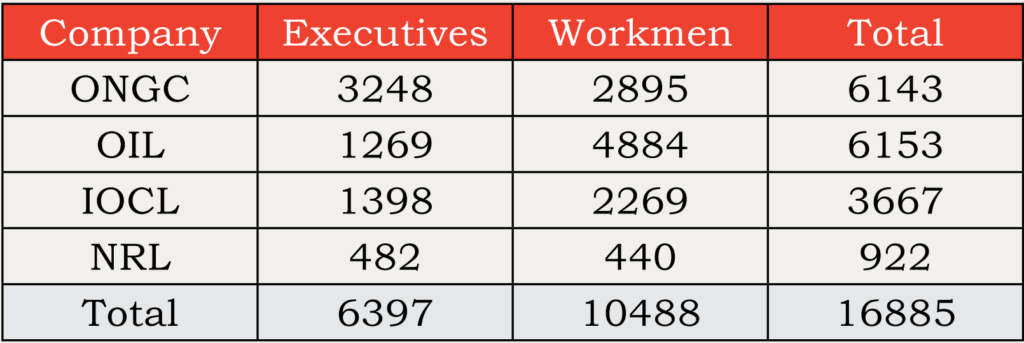 Developing the North Eastern Region as a dominant hydrocarbon hub
Developing the North Eastern Region as a dominant hydrocarbon hub
Transition towards use of natural gas as sustainable forms of energy, developing a natural gas grid, development of CNG highways, and better utilization of gas produced in North Eastern Region from domestic and marginal fields by a robust gas pipeline distribution network
One of the flagship components of this Vision is linking the North Eastern Region to the National Gas Grid (NGG) through 2 (two) Gas Pipeline Projects – viz. (1) Barauni Guwahati Pipeline Limited (BGPL) under GAIL India Limited, which would link Barauni (already connected to the NGG) to Chandrapur near Guwahati; and (2) North East Gas Grid under M/s Indradhanush Gas Grid Limited (IGGL) – a Joint Venture company of 5 major P&NG CPSUs [viz. GAIL, IOCL, OIL, NRL & ONGC]. These projects are going on in full swing.
Meanwhile, the Assam Government has acquired 26% of equity in NRL making its biggest corporate investment. NRL on its part is establishing a 2G bio refinery in association with 2 (two) Finnish companies – viz. Fortum and Chempolis. Assam Government is also contemplating acquiring a 26% stake in BVFCL with the aim to revive this heritage fertilizer plant at Namrup. Further, a JV company – Purba Bharati Gas Private Limited (PBGPL) has been set up to establish City Gas Distribution systems in Kamrup, Kamrup (Metro) and the 3 (three) Barak Valley Districts. PBPCL is expected to provide piped gas for domestic consumption (PNG) as well as CNG for the transport sector.
Recently ONGC declared that it would invest nearly `130 billion in Assam between 2019 and 2024. As per ONGC and OIL forecasts, oil production in the NER would reach 5.92 million metric tons per annum (MMTPA) and natural gas production 20.57 million metric standard cubic meters per day (MMSCMD) by FY2025. The major portion of this production is attributable to Assam.

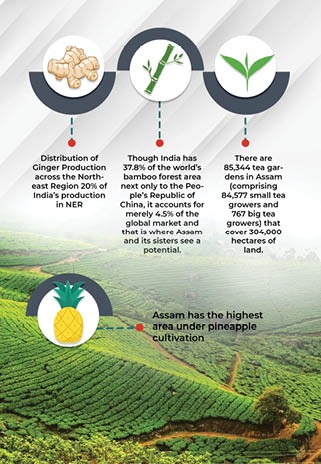 Even as state is poised to play a major role in high rise sectors, agriculture continues to support more than 75% of Assam’s population and employment to more than 50% of total workforce. This indicates that majority of the population depends on the state’s least productive sector for livelihoods. The bright spot is Assam has the highest area under pineapple cultivation among Indian states and both kew and queen varieties at Dima Hasao (North Cachar Hills), Karbi Anglong, Cachar, Kamrup, and Hailakandi districts together contribute 60% of the pineapple production area in Assam and at 166,500 MT in 2016/17, Assam is the largest producer of ginger across Indian states. Main ginger producing districts are Barpeta, Kamrup, Darrang, and Sonitpur. Distribution of ginger production across the Northeast Region is 20% of India’s production in NER with huge potential to upscale, improve organic farming and establish marketing linkages.
Even as state is poised to play a major role in high rise sectors, agriculture continues to support more than 75% of Assam’s population and employment to more than 50% of total workforce. This indicates that majority of the population depends on the state’s least productive sector for livelihoods. The bright spot is Assam has the highest area under pineapple cultivation among Indian states and both kew and queen varieties at Dima Hasao (North Cachar Hills), Karbi Anglong, Cachar, Kamrup, and Hailakandi districts together contribute 60% of the pineapple production area in Assam and at 166,500 MT in 2016/17, Assam is the largest producer of ginger across Indian states. Main ginger producing districts are Barpeta, Kamrup, Darrang, and Sonitpur. Distribution of ginger production across the Northeast Region is 20% of India’s production in NER with huge potential to upscale, improve organic farming and establish marketing linkages.
Another area for Assam to play a major role and generate revenues is in bamboo. Though India has 37.8% of the world’s bamboo forest area next only to the People’s Republic of China, it accounts for merely 4.5% of the global market. The only other agricultural crop, if tea may be included, has a vast magnitude. There are 85,344 tea gardens in Assam comprising 84,577 small tea growers and 767 big tea growers) that cover 304,000 hectares of land.
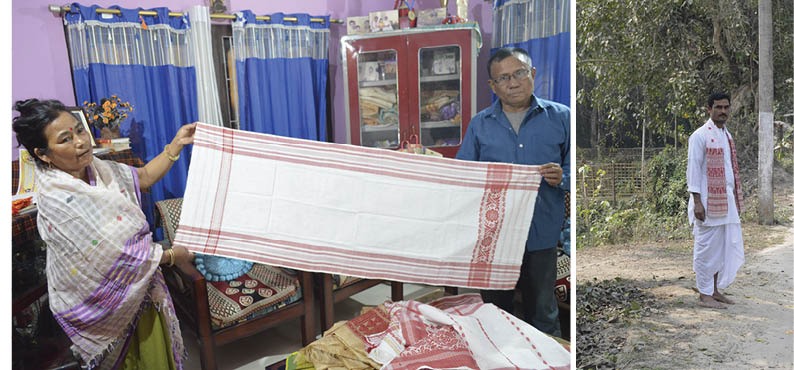 Speaking about the potential, experts say that entering into the value chain with ‘Farming-as-a-Service’ will help reduce upfront costs and labour cost of pineapple cultivation. Coupled with this, containerized movement of fresh pineapples to the rest of India and export to neighbouring countries and the Gulf region would become easy. Similarly, bamboo (technically a grass) which is fast growing can be used for a variety of products including furniture, flooring, mat boards, charcoal, paper, scaffoldings. Dilip Kumar Borah, Secretary, Finance, Handloom, Textiles & Sericulture, Government of Assam says, India accounts for just 4.5% of global market and Assam is at the cusp of taking off and harnessing the vast potential that bamboo and silk produced here has.
Speaking about the potential, experts say that entering into the value chain with ‘Farming-as-a-Service’ will help reduce upfront costs and labour cost of pineapple cultivation. Coupled with this, containerized movement of fresh pineapples to the rest of India and export to neighbouring countries and the Gulf region would become easy. Similarly, bamboo (technically a grass) which is fast growing can be used for a variety of products including furniture, flooring, mat boards, charcoal, paper, scaffoldings. Dilip Kumar Borah, Secretary, Finance, Handloom, Textiles & Sericulture, Government of Assam says, India accounts for just 4.5% of global market and Assam is at the cusp of taking off and harnessing the vast potential that bamboo and silk produced here has.
There is a growing awareness about bamboo timber that can be a wood substitute and can substitute imported wood logs. Preservative-treated bamboo poles could be used to make high-end profitable components in houses, resorts, school buildings, pantries, prefab houses for temporary shelters. Prashant Lingam of Bamboo House India who has been promoting bamboo houses in Telangana says, “When we started promoting bamboo houses in 2008 people were sceptical but today the acceptance has grown. Few know that a bamboo roof can take 7 tonnes load.” Then there is a huge market for round stick incense, presently imports comprise 25% of the requirement.
Tea industry in Assam contributes more than `50 billion annually as agriculture income and adds to foreign exchange earnings through its exports. Most tea gardens are located in Dibrugarh, Sivasagar, Lakhimpur, Darrang, Nagaon, Kamrup, Goalpara, Karbi Anglong, Jorhat, Golaghat, Tinsukia, Sonitpur, Dima Hasao, and North Cachar Hills districts. Assam tea is exported to more than 70 countries.
The rise of Assam has a lot to do with leadership and the face of Assam, the Chief Minister of Assam who is now being viewed as a leader with a mission is in a tearing hurry to get things done. The focus on the North East by the centre too has helped in more ways than one. The Prime Minister Narendra Modi visited the Northeast states 44 times between 2017 and 2022 which explains the importance that the centre attaches to the region.
The sense of urgency and hunger that is palpable when one visits the State Secretariat. A senior official says, “The Chief Minister leads from the front and the others also need to. There is just no alternative.” The clarity of thought and the acceptance that Assam is now ready to go is evident.

